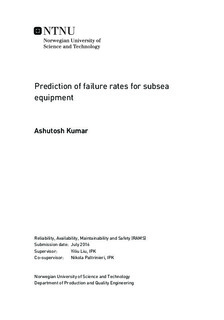Prediction of failure rates for subsea equipment
Master thesis
Permanent lenke
http://hdl.handle.net/11250/2414762Utgivelsesdato
2016Metadata
Vis full innførselSamlinger
Sammendrag
Prediction of failure rate for new subsea equipment is a challenge in oil and gas industry mainly due to lack of relevant data and use of increasingly novel technologies. There is a lack of common guideline or framework for failure prediction process of novel technology and different companies and experts follow different procedures.Many new technologies like Subsea processing with a subsea gas compression module installed at Åsgard field in Norway as recent as 2014 are emerging. The thesis proposes failure rate prediction method for new subsea equipment. The failure rate calculated is intended to be used as an important input for TQP during the early design phase. A comprehensive literature review to study the reliability databases and other methods like BBN, ANN, Rahimi and Rausand s approach is done. The literature study was divided into two parts, reliability databases and other methods. Most of the generic methods do not consider the dynamic operational and environmental conditions during prediction process. It describes methods for failure rate prediction namely Regression models, Rahimi and Rausand s approach, Bayesian Networks and Artificial Neural Network. A new approach is proposed using the available models. It mainly uses the weight parameters for RIFs and failure causes as inputs from Rahimi and Rausand (2013) and uses a BBN to calculate the failure rate for all failure modes of new subsea equipment. A BBN model is developed for quantifying the states of RIFs and its effect on failure cause and the failure rates of different failure modes of subsea equipment.
